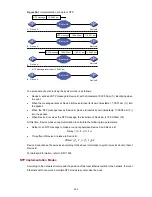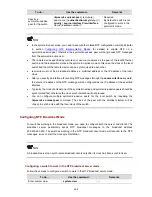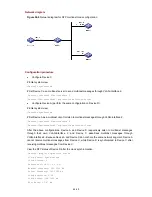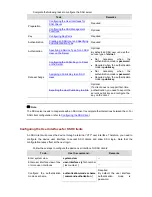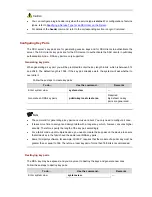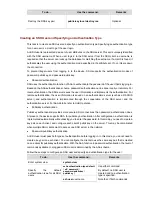
Configuration procedure
z
Configure Device C.
# Set Device A as the NTP server.
<DeviceC> system-view
[DeviceC] ntp-service unicast-server 3.0.1.31
z
Configure Device B (after the Device C is synchronized to Device A).
# Enter system view.
<DeviceB> system-view
# Set Device C as the peer of Device B.
[DeviceB] ntp-service unicast-peer 3.0.1.33
Device C and Device B are symmetric peers after the above configuration. Device B works in symmetric
active mode, while Device C works in symmetric passive mode. Because the stratum level of the local
clock of Device B is 1, and that of Device C is 3, the clock of Device C is synchronized to that of Device
B.
View the status of Device C after the clock synchronization.
[DeviceC] display ntp-service status
Clock status: synchronized
Clock stratum: 2
Reference clock ID: 3.0.1.32
Nominal frequency: 100.0000 Hz
Actual frequency: 100.0000 Hz
Clock precision: 2^18
Clock offset: 0.66 ms
Root delay: 27.47 ms
Root dispersion: 208.39 ms
Peer dispersion: 9.63 ms
Reference time: 17:03:32.022 UTC Apr 2 2007 (BF422AE4.05AEA86C)
The output information indicates that the clock of Device C is synchronized to that of Device B and the
stratum level of its local clock is 2, one level lower than Device B.
# View the information about the NTP sessions of Device C (you can see that a connection is
established between Device C and Device B).
[DeviceC] display ntp-service sessions
source reference stra reach poll now offset delay disper
*************************************************************************
[1234]3.0.1.32 LOCL 1 95 64 42 -14.3 12.9 2.7
[25]3.0.1.31 127.127.1.0 2 1 64 1 4408.6 38.7 0.0
note: 1 source(master),2 source(peer),3 selected,4 candidate,5 configured
Total associations : 2
54-17

